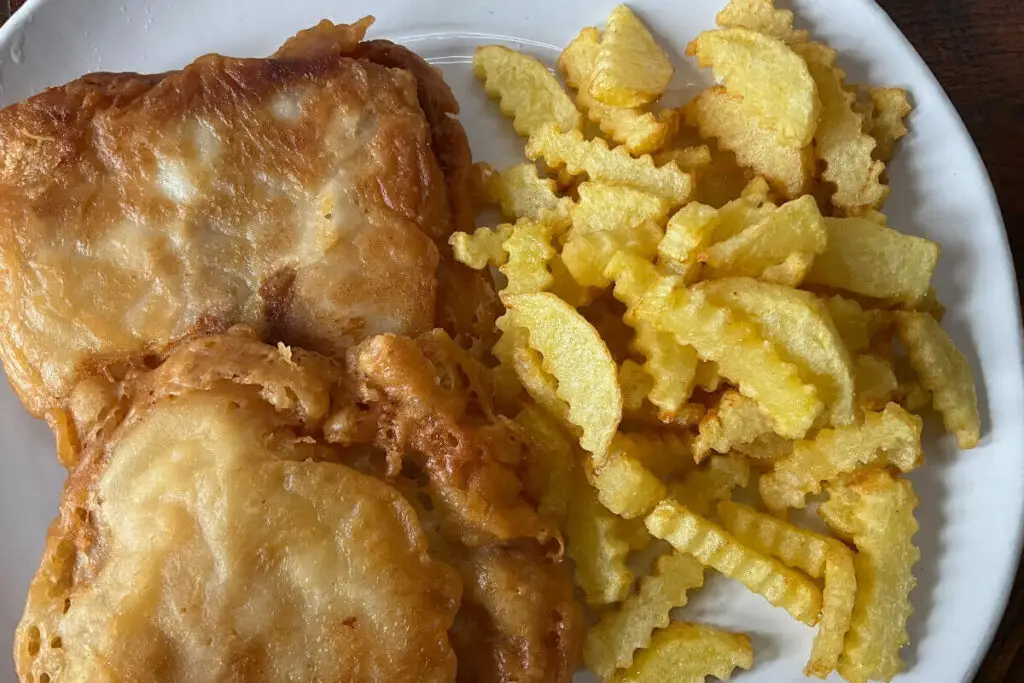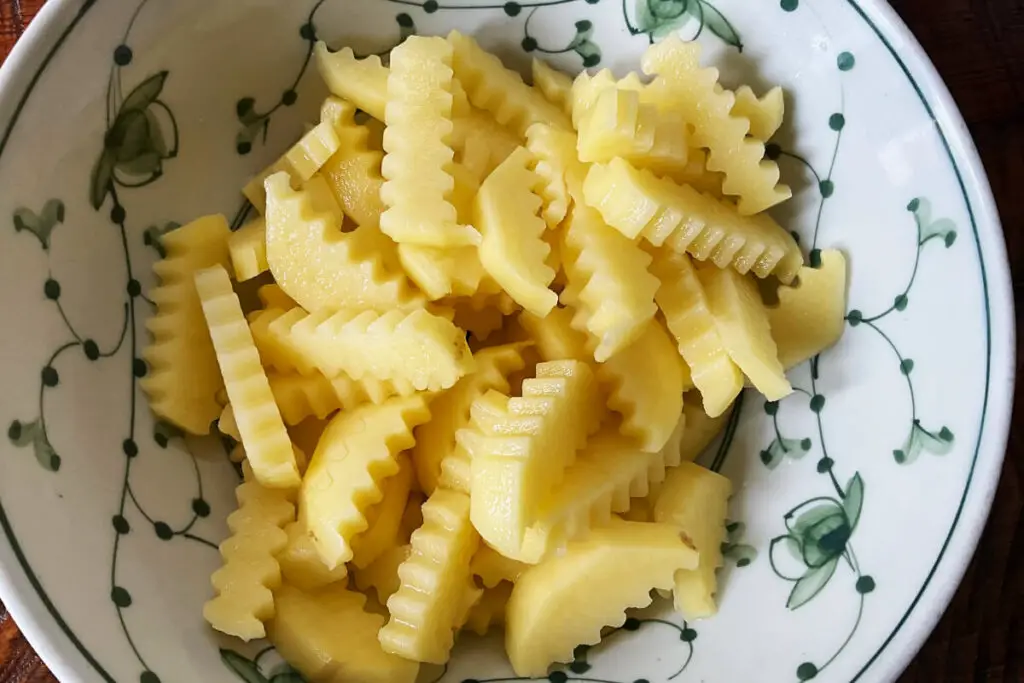If you have a penchant for British Fish and Chips, you don’t need to journey to England to savor an authentic taste. With this recipe, you can whip up traditional-style fish and chips in the comfort of your own home.
The origins of fish and chips are fascinating, tracing back to how this dish became emblematic of England’s culinary culture. We also offer guidance on crafting impeccable fish and chips, ensuring a flavor reminiscent of a visit to a classic chippy in the U.K.
Table of Contents
- Fish And Chips: A Dish Wrapped In History
- Fish And Chips: A Global Affair
- Creating The Perfect Fish: A Culinary Guide
- Mastering The Perfect Chips (or French Fries): Essential Tips
- The Authentic British Fish ‘n Chips Recipe
Fish And Chips: A Dish Wrapped In History
Fish and chips, a beloved British staple, evokes the nostalgic essence of the U.K. with its golden-fried goodness. But its origins stretch far beyond the British Isles. To understand the history of this dish is to explore the journey of cultures, technological advances, and gastronomic traditions.

Origins Far From The British Isles
Contrary to popular belief, fish and chips did not originate in England. Its history traces back to 15th Century Portugal, where Jews, Muslims, and Christians coexisted under Moorish rule.
With the religious turmoil of the era, many Sephardic Jews, facing expulsion or forced conversion, fled to England, taking with them their culinary traditions. One such dish was fried fish, typically prepared before the Jewish Sabbath and eaten cold the following day.
It soon gained popularity, with Jewish vendors selling this “fried fish in the Jewish fashion” on London’s streets.
Enter The Chip For The Fish’ n Chips.
While the fish’s origin has its roots in Sephardic Jewish tradition, the origin of the “chip” is murkier. Belgium claims the title, with stories of locals frying potatoes in the shape of fish during a harsh winter in 1680 when the River Meuse froze over.
Regardless of its origins, by the mid-19th century, chips had arrived in England.
A British Match Made In Gastronomic Heaven
In the late 19th century, they witnessed the unison of fish and chips, largely thanks to the industrial-scale trawl fishing in the North Sea and expanding railway lines. The first fish and chips shop, many historians claim, was opened by a Jewish immigrant, Joseph Malin, in London around 1860. By 1910, the U.K. boasted 25,000 fish and chip shops.
Fish ‘n Chips – The Dish That Fueled Wars
During both World Wars, fish and chips were essential in bolstering morale. It remained off the ration list, with Prime Minister David Lloyd George ensuring its availability during WWI and Winston Churchill dubbing fish and chips “the good companions” during WWII.
Legend even has it that British soldiers identified each other during D-Day with the call-and-response of “Fish!” and “Chips!”
Modern Interpretations And Traditions Of Fish’ n Chips
In contemporary times, the dish has held its ground against other contenders, like chicken tikka masala, for the title of Britain’s national dish. Some traditions, like wrapping fish and chips in newspaper, have faded, while the accompaniments have diversified beyond salt and malt vinegar to curry sauce and even ketchup.
Fish ‘n Chips Are About Understanding And Celebrating Heritage.
The fish and chips story is more than just about food. It’s about understanding the migrations, the melding of cultures, and the historical events that shape our cuisines. Knowing its history enriches the experience of every bite, turning a simple dish into a historical journey.

Fish And Chips: A Global Affair
The crispy allure of fish and chips has swum well beyond the British shores, becoming a favorite in many corners of the world. As it has traveled, it has adapted to regional palates, picking up unique accompaniments and dipping sauces and reflecting the gastronomic preferences of its new homes.
Let’s embark on a culinary voyage to explore how different countries have added their local twists to this universally loved dish:
Australia:
Down Under, fish and chips are often enjoyed at the beach. As the waves crash, Aussies prefer to complement their fried fish with a creamy tartar sauce, which provides a tangy contrast to the richly fried fish.
England:
The birthplace of this dish retains a rather minimalistic approach. Malt vinegar, with its sharp, tangy flavor, cuts through the grease of the chips, enhancing the overall flavor profile. Paired with a sprinkle of salt, it’s a match made in heaven.
Belgium:
Known for their frites (fries), it’s no surprise that the Belgians have embraced fish and chips. Their love for mayonnaise as a dip transcends to this dish, with its creamy texture as the perfect counterpart to the crispy batter.
Scotland:
Taking a detour from the classic vinegar, Scots often reach for the brown sauce. This sauce, a mix of vinegar, tomatoes, molasses, and a blend of spices, adds a sweet, tangy, and slightly peppery note to the fish and chips.
Denmark:
The Danes have put their spin on it with remoulade, a condiment initially from France. This pale yellow sauce is typically made of mayo, mustard, chopped pickles, and herbs, presenting a delightful burst of flavors with each bite.
U.S.A:
The vastness of the U.S. means variations abound, but many Americans echo the Australian preference for tartar sauce, relishing its creamy and tangy attributes. Additionally, ketchup and lemon wedges often make an appearance on American plates.
As fish and chips continue their global journey, they testify to how a dish can be universal and local. While cherishing the essence of crispy fish paired with golden chips, each country brings its cultural nuances to the table, making fish and chips a truly international delight.
Creating The Perfect Fish: A Culinary Guide
Creating the perfect fish and chips requires a blend of technique, quality ingredients, and timing. Let’s delve into the essential steps and tips to ensure you achieve that quintessential crispy outside and tender inside every time:

Cold Beer For The Batter:
The beer you use for your batter plays a significant role. Always ensure it’s cold; warm beer will compromise the texture of the batter. The cold temperature helps create a crispier end product.
Freshness Matters:
Once your batter is prepared, use it immediately. Fresh batter adheres to the fish better, ensuring a uniform coat that fries up beautifully.
Key Ingredients:
The magic in the batter lies in two primary ingredients: beer and baking powder. Together, they create a light, airy, and crispy batter. The beer’s carbonation and the baking powder’s leavening power produce a golden and crunchy crust.
Dredging Is Essential:
Never skip dredging the fish in flour before dipping it in the batter. This ensures that the batter sticks to the fish uniformly. As a result, your fish gets that desired crisp exterior while retaining a moist, flavorful interior.
Choice Of Fish:
The type of fish you choose can make or break your dish. Always opt for a white fish. Basa is a great option, but traditional favorites like cod, haddock, or white ocean fish will work beautifully. These fish have a mild flavor and flake beautifully when cooked, complementing the crispy batter.
Frying Perfection:
Avoid over-frying your fish. Once it achieves that golden brown hue, it’s time to remove it from the oil. Post-frying, let the fish rest on a wire rack or paper towel. This step drains excess oil, ensuring your fish remains crispy but not greasy.
Remember, the hallmark of the best fish lies in its contrasting textures: the exterior should be crispy, while the inside remains tender and flaky. And, of course, the dish should not be overly oily. Follow these guidelines, and you’re well on your way to mastering this beloved classic!
Mastering The Perfect Chips (or French Fries): Essential Tips
Achieving impeccable chips or french fries is an art, merging technique with the right ingredients. Here’s a step-by-step guide to creating the ultimate chips:

Preparation:
Begin by selecting the right kind of potatoes; russet potatoes or Maris Piper are excellent choices. Peel the potatoes and slice them evenly. Uniformity in size ensures even cooking.
Pre-Fry Soak:
Soak the cut potatoes in cold water for about 30 minutes to an hour to remove excess starch, which can inhibit crispness. Drain them well and pat them dry with a kitchen towel to ensure there’s no moisture left.
Heat The Oil:
Your oil must be at the right temperature before frying. Using vegetable oil, as it has a high smoke point, heat it until it’s hot. A deep-fry thermometer can be handy. Aim for a temperature of around 350°F (175°C).
Frying:
Fry the potato slices in batches to avoid overcrowding, which can drop the oil’s temperature and result in greasy chips. Ensure they achieve a golden-brown color, signaling they are perfectly cooked.
Draining:
Once fried to perfection, remove the chips with a slotted spoon and place them on a plate lined with paper towels. This helps drain any excess oil and ensures your chips aren’t overly greasy.
Seasoning:
While the chips are still hot, sprinkle them with salt. Salt doesn’t just add flavor; it also enhances the natural taste of the potatoes.
Remember, the goal is to achieve crispy chips on the outside while maintaining a softer, fluffy texture. Following these steps will help you craft the quintessential potato chip, perfect as a side dish or a snack in its own right!

